In Timemelters, time is a shoelace. It bends and twists. What you’ve done with one part of the lace can effect the other parts in unusual ways. You get loops, but also knots and snarls and tangles. Sometimes, you get bows.
Listen. Just yesterday – yesterday in the real world – I was running up a snowy hill – this part was not in the real world – and I saw a bunch of enemies ahead of me, closing in on a friend of mine who had no defences. If my friend died, it would be bad: game over. I was out of range and out of mana, but I was also close enough to attract my enemies’ attention, and they started to run at me. Stumped, my hands left the keyboard: I had pretty much given up. And then I watched, stunned, as someone entirely new raced into frame and briskly zapped all the enemies dead. I blinked. My friend who had no defences survived. I, who was out of mana, survived. And the person who had come to our aid was…me? An earlier me. Me from about five minutes ago. Welcome to Timemelters.
Fittingly for such a temporally complex game, let’s start by going back a bit. Not back to the 16th century, where Timemelters is set, in a Scotland riddled with witch trials and supernatural paranoia, but back to Sang-Froid: Tales of Werewolves, a gloriously weird strategy-action hybrid from 2013. Sang-Froid is a proper masterpiece if you ask me, and it’s a strange masterpiece, which makes it even better. You play as a lumberjack whose sister, I think, is being targeted by the devil. Every night the devil sends wolves to attack your farm and so you place traps, lay defences, and also run around the joint in real-time smacking these beasts about with an axe. During the day, you work chopping lumber to earn money to build up your traps and defences for the night ahead.
It’s magical, genuinely so. It’s a tactics game – with the wolves headed for the centre of your farm, and the expanding annulus of traps you lay down, it’s almost a tower-defence game. But it’s also a real-time action game because once those wolves appear you’re out there in the snow with them, listening for them, leading them with yells and your scent to spots where you can do them in. It’s a game about being overstretched, almost constantly exhausted. And it’s exhilarating.
And Timemelters is an almost-sequel. It has some of the same developers, who have split off to form a new studio, and it has a lot of the same ideas, but they’ve evolved and been transformed. 19th century Quebec has become olde Scotland in the grip of witches and spirits. The farm has given way to lots of different maps as you race back and forth between small towns and farms and citadels. The wolves have been replaced with a range of eldritch monsters – like pawns, who come en masse, like plagues, which are huge piggy beasts who must be shot in the back – and you’re no longer a lumberjack. You’re a witch who controls both time and space – to an extent.
I first saw videos for Timemelters back when it was still called Wicca, and it remains one of the most thrilling prospects I’ve ever witnessed. Start on a strategic view of a map, with a doodad to protect at the centre and lots of red lines converging – the paths that enemies are going to take towards the doodad. So far, so Sang-Froid. But then you drop into the action as a witch and you have much more than an axe now. You can attack gaggles of enemies and then stop, rewind time, and fight alongside the echo of yourself that you just recorded. Double, triple, quadruple the firepower. You can bewitch stones to create walls that affect the paths taken by your advancing enemies, allowing you to channel them, bunch them. You can bewitch trees, which become huge spindly turrets, killing anything that walks beneath their branches, giving you targets to channel your enemies towards. You can place a range of spells that will tether baddies to the ground with knots, or will unleash a fire demon on them and kite them even as it whittles them down, or will summon a huge mirrorball of death. Or you can fire up a bunch of stone circles on the maps, which allow you to move between them almost instantaneously, crumpling space into a paper ball much as your echoes have already crumpled time.
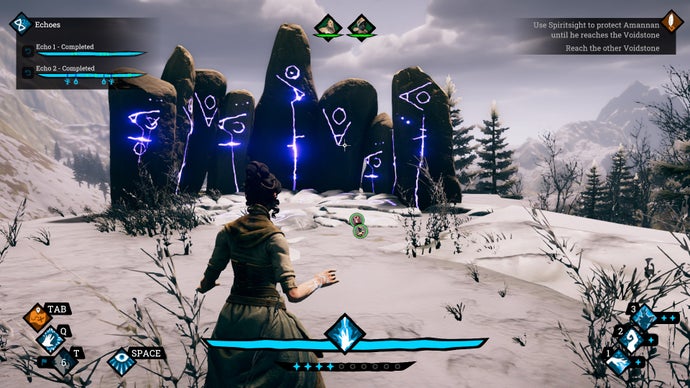
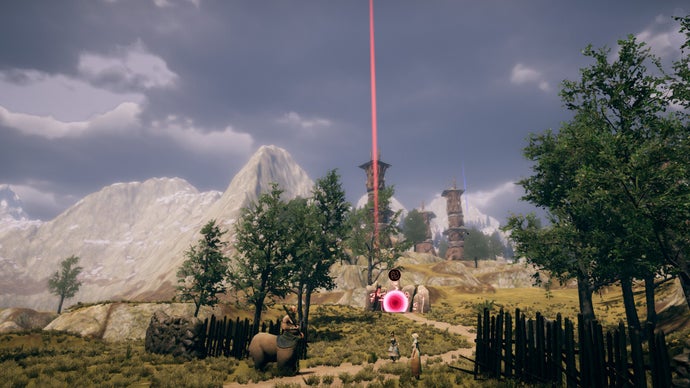
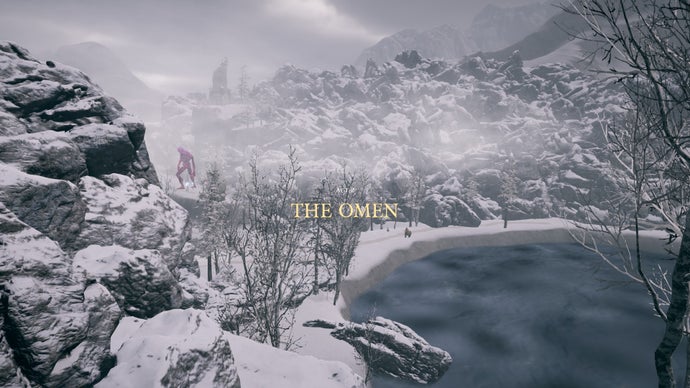
It was actually this last element that blew me away the most, and continues to blow me away whenever I play Timemelters. The stone circles are placed in specific spots on the map, and you need to cast a spell to activate them. Once you do, though, you enter a portal system that allows you to travel between these spots quite quickly. Crucially, though, it’s not instantaneous. You still spend travelling time in the white void between each stone portal. Time in which bad stuff can happen out there in the field, but also time you can use. In one game last week, I was low on the mana that controlled my basic attack, and I had a huge bunch of enemies I needed to get rid of. What I did was ingeniously cowardly, even if it felt like cheating. I would shoot until I ran out of mana, and then duck into the portal while I recharged, safe in the knowledge my enemies could not follow. Then I’d rush out and blast them again once they’d lost interest and were wandering off. Repeat.
Repeat. Timemelters today is very much that game that Wicca promised to be, but it’s had a lot of time in development and it’s no longer as overwhelming as it sounds. Enemies and skills are introduced slowly and carefully. At first all you have to know is that you’re a witch with powerful spells but only 1 hit point – you’ll die the first time you take damage. Then you learn about globes of mana you can collect from downed foes that allow you to power up special moves, like bewitching trees and stones, and which might prompt you towards attacking your foes in a specific sequence. Then you learn about creating echoes, and what this does to the enemies you face. You learn how, on a second loop, when you’ve already laid down an echo of yourself, the game will mark enemies who are currently still alive but who your echo will arrive soon to kill. You learn about time distortion, which is when, in a current loop, you alter the reality of an echo on a past loop, killing enemies they were meant to kill, or unleashing new enemies that will now kill the echo before they finish their original loop. Then you learn about protecting fragile NPCs, and then you learn…
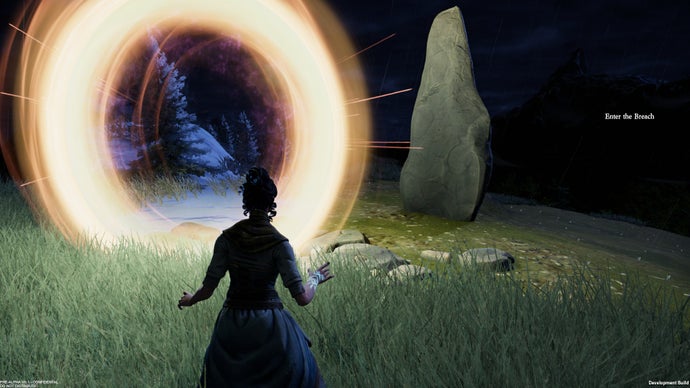
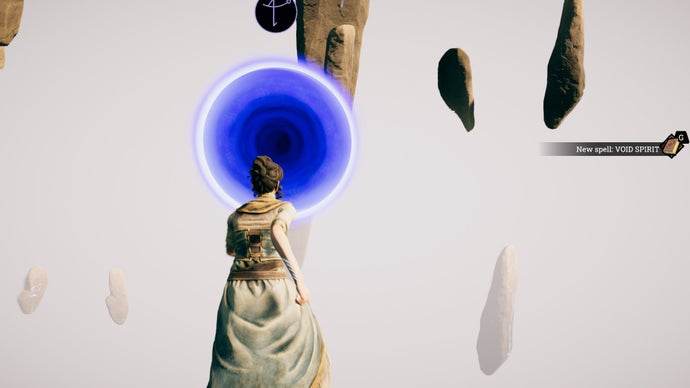
Onwards. By mid-game, I was astonishingly over-powered. I had not one but two main attacks, each powered in different ways, and two different sets of spells. I could create echoes and rush between stone circles in non-Euclidean Pac-Man space or whatever it is, but I could also turn into a wolf temporarily to dash past foes and get the drop on those baddies that could only be killed from behind.
Crucially, though, the game had evolved too, taking the simple tower defence set-up and creating escort missions, horde modes, bosses. One particularly memorable level saw me protecting an ally from one bank of a river while enemies attacked on the other – and there was no way to cross the river to engage directly. Another had a boss that split into four parts, each of which had to be killed at the same time, which meant that I had to use my echoes to reach the four parts of the boss scattered about a huge map, but I also had to consider time of flight and time of arrival, to synchronise four different attacks in a world in which I had already tangled space and time so tightly I’d need a penknife to separate them again.
Lots of games can be complex, of course. And various parts of Timemelters are actually things I’ve seen before. Creating echoes, say, is a neat idea you can also find in a game called Time Rifters, and in the old Capy number Super Time Force. But a couple of elements come together with Timemelters to make it properly special to me. Its parts are lovely, but it’s consistently more than its parts.
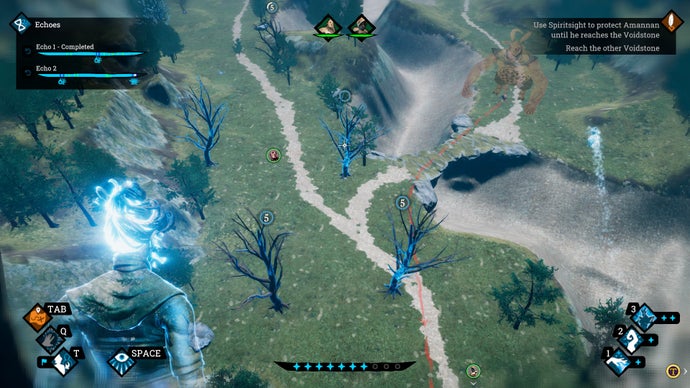
One of these elements is the maps, which are both lovely rugged chunks of Highland nature and also intricate mazes filled with possibilities, where enemies can be rerouted, wrong-footed, lead astray, but where you too can lose your way so badly that only an earlier version of yourself you’d already forgotten about could come to your aid. (It’s beautiful in its way, too. Timemelters is an interesting looking game – the characters have the sallow, shadowed faces of Edward Hopper characters – but its feel for nature is gorgeous. Nature here is bracken parting as you push through. It’s snow crunching underneath your feet. It’s night with the fire of a burning village sending sparks through the trees as you approach. The people who made this have spent a lot of time in the solitude you find around trees.)
Another element that makes it all work is that Timemelters knows what it is, and it has a very clear sense of itself. It’s strategy, tactics, and real-time action, it’s planning and sweaty execution. But step back and it’s also just puzzles and combat. Each map presents a puzzle to be solved and combat that must be handled in order to solve the puzzle. It’s encounters, but also your choice of how, when, where to engage, and with how many copies of yourself. The game understands all this to the extent that it grades each level with both a puzzle and combat difficulty setting, and because the game understands what it’s about, so will you. And so you will solve the puzzle, fight the combat, and then come back to see if you can do it in a different way too. And another different way?
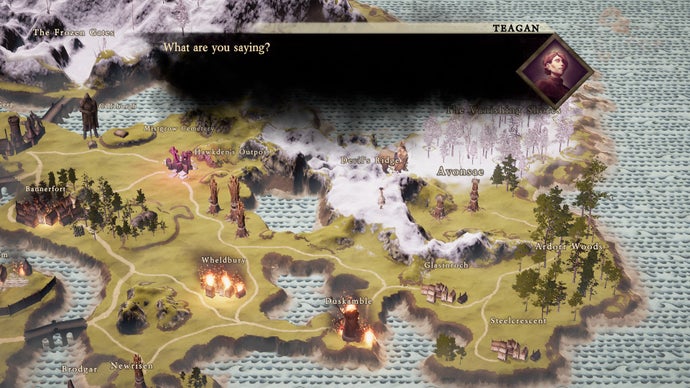
The final element is that this world, which seems so in thrall to game-breaking magical powers, has clear boundaries alongside its clear objectives. Each level tells you what’s at stake: protect this person, kill all these things, reach this point. But it also has clear rules for what fits into the timeline and what sits outside of it. Open portals and they’ll always be open. Bewitch a tree five minutes into a loop, and you’ll need to wait five minutes after starting another echo for the tree to be bewitched again. The fact that you only have one HP is enormously clarifying: there’s no fudging things when you’re either alive or instantly dead. The fact that the game both engages in time distortion and manages to make you understand the effects of time distortion allows time distortion itself to become a mechanic. It’s a wild game empowered by some very clear thinking.
And the end result, for me, is that it feels like a genuine sandbox. Each level, even the ones that are initially overwhelming, feels playful enough for me to go back in after a defeat and just mess with the variables until I find a new way forward. Maybe I’ll spend my first echo just gathering all the resources I can so I can unleash spells on the second echo. Maybe I’ll lead everyone over here and then come back later – and earlier – to do them all in. Last week I woke up in the middle of the night – in the real world – and realised that I could place a teleport spot at a point in the map I had not even considered and it would blow the game wide open. A game that works its way into your dreams? Yes please.
I think sandboxes are a bit like gaming’s Rorschach test. The term means different things to different players, and people react to sandbox games in different ways. But Timemelters is my kind of sandbox: the stakes are clear, the tools are bewilderingly powerful, and frequently just bewildering, and you are always in control, and always on the edge of losing control. Like Sang-Froid before it, Timemelters has been the best kind of friend to me. It challenges me. It confuses me at times. But it shows my things that I could not imagine, and then it lets me do them. And when I’m stuck, I often see a figure on the horizon running to help me out – and the figure is me.
A copy of Timemelters for review was provided by Autoexec Games.
